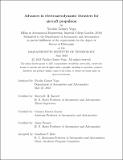Advances in electroaerodynamic thrusters for aircraft propulsion
Author(s)
Gómez Vega, Nicolás
DownloadThesis PDF (13.21Mb)
Advisor
Barrett, Steven R. H.
Terms of use
Metadata
Show full item recordAbstract
An electroaerodynamic (EAD) thruster is a propulsion system for small aircraft that is mechanically simple, has no moving parts, and is nearly silent. EAD thrusters produce ions from atmospheric air and accelerate the ions across two electrodes separated by an air gap: collisions of ions with neutral molecules result in momentum transfer to the neutral air, generating an ionic wind and a thrust force. EAD has been demonstrated to be a feasible form of propulsion for airships and, recently, for airplanes. A major challenge that has to be overcome is that EAD thrusters have a low thrust density (thrust per unit volume or frontal area) compared to conventional propulsion systems, such as propellers.
This thesis focuses on thruster physics and explores different techniques to improve the thrust density and/or efficiency of EAD thrusters. Four studies are conducted to achieve these goals. The first one is a study of “decoupled” EAD thrusters with a dielectric barrier discharge ion source, in which the ionization and ion acceleration processes are separated. This is different from alternative EAD architectures using corona discharges, in which these processes cannot be independently controlled. By using benchtop and thrust-measurement tests, it is found that the current and thrust produced by these decoupled devices scales with the DC voltage and gap distance in the same manner as the ideal space-charge limited current in a thin ion slab. Similarly, the results show that current is mostly affected by the power draw of the ion source instead of by the ion source parameters independently.
The second study involves reverse emission, a critical non-ideal effect that increases power consumption and lowers the sparking voltage without contributing to thrust. This work shows that reverse emission is caused by a gas discharge in the ion-collecting electrode, primarily at its two ends. Several techniques to mitigate this discharge are identified; all of these consist of modifying the electrode geometry to weaken the electric field at the tips. If reverse emission is mitigated, it is possible to achieve substantial improvements in power consumption, maximum thrust, and noise signature.
The third study is a theoretical investigation of multistaged ducted (MSD) thrusters containing several serially-stacked EAD stages enclosed in a duct. The duct also includes an inlet and a nozzle and is hypothesized to provide a thrust component similar to that in ducted fans. Combining momentum theory with relevant models for the EAD stage performance, it is shown that MSD thrusters have the potential to provide order-of-magnitude improvements in thrust density and thrust-to-power ratio with respect to single-stage devices.
The fourth study involves an implementation of multistaged EAD thrusters to both establish their performance and validate the predictions from theory. Single-stage experiments suggest that stages with small gap distances are advantageous as they provide a high force on the fluid per unit volume. By stacking multiple stages in series, it is found that the thrust density can be significantly increased as compared to single-stage thrusters: 10 stages provide a factor of 5.6 increase in thrust at the maximum voltage tested. However, these improvements occur with diminishing returns due to increasing pressure losses as more stages are added. The theoretical models are found to be consistent with the experimental data, being able to capture the effects of all the physical parameters tested.
The work in this thesis provides a pathway for developing EAD thrusters that could deliver a high thrust density at a practical thrust-to-power ratio, potentially enabling EAD-propelled aircraft to perform useful missions.
Date issued
2023-06Department
Massachusetts Institute of Technology. Department of Aeronautics and AstronauticsPublisher
Massachusetts Institute of Technology